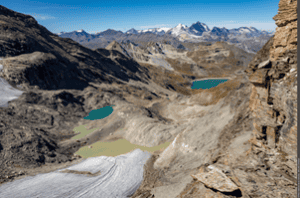The glaciers of the Alps rank as the fastest melting in the world. They have lost 40% of their mass since the beginning of the 20th century, according to a recent study published in the journal “Nature”.
From the Aletsch glacier in the Bernese Alps to the Mer de Glace suspended above Chamonix, even the largest and most famous ice masses in our mountains are threatened by our greenhouse gas emissions. Confronted with this, we only have one solution: to mitigate climate change. This ambition is all the more important as the cryosphere plays an essential role as a carbon sink and supports the availability of water in dry periods.
Retreating glaciers make way for new ecosystems which are being studied as part of the Ice&Life project, initiated by Asters, a French association specialised in Alpine biodiversity. Initial results have shown that rare and protected species are appearing in a wide range of new habitats such as primary forests, grasslands, wetlands and lakes, the latter representing precious freshwater reserves. These ecosystems are therefore assets for biodiversity, and through it for our society.
However, these deglaciated areas are still little understood nor recognized. On a global scale, only 30% of them are protected by law, leaving the rest vulnerable to various projects that could damage them. In order to preserve these new environments and all the ecosystem services they provide, it is imperative that the political players guarantee their free evolution.
 In this picture from the Grand Sassière pilot site of the Waterwise project, one can clearly see the lakes created after the glacier’s retreat. In the foreground, we can see two lakes with a green color as they are still connected to the glacier, which brings particles into it (hence the color). The blue lake, the one close to the previous ones, is not connected to the glacier anymore, and is therefore very blue. The lake in the distance is semi-natural as it is held by a dam for hydroelectricity, so it is not linked to this post-glacial problematic and is bright-blue colored.
In this picture from the Grand Sassière pilot site of the Waterwise project, one can clearly see the lakes created after the glacier’s retreat. In the foreground, we can see two lakes with a green color as they are still connected to the glacier, which brings particles into it (hence the color). The blue lake, the one close to the previous ones, is not connected to the glacier anymore, and is therefore very blue. The lake in the distance is semi-natural as it is held by a dam for hydroelectricity, so it is not linked to this post-glacial problematic and is bright-blue colored.
Article by Réserves Naturelles de France



